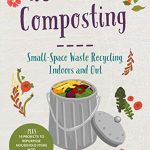No-Waste Composting: Small-Space Waste Recycling Indoors and Out by Michelle Balz
I’m always looking for ways to improve my garden and understanding composting is one way of doing that. I have yet to get a compost pile started in my backyard, but after reading No-Waste Composting by Michelle Balz, I’m wondering if there is no time like the present.
Book Chapters and Contents
There are 7 chapters in this book, each giving you better insight on what composting is, how start and maintain a compost pile, and great tips for small space composting. The seven chapters are: No-Waste Lifestyle and Benefits of Composting; Composting Basics; Low-Maintenance Outdoor Composting; Integrate Composting into Your Garden; Unique Indoor Composting Systems; Composting Pet Manure in Your Backyard; and Harvesting and Using Your Finished Compost.
The best thing I love about this compost book is the author’s theme of no-waste and her emphasis on reducing an individual’s carbon footprint and “shopping with intention:”
Setting aside food scraps for composting in your backyard makes you keenly aware of how much food you waste. Some things, such as banana peels and melon rinds, are unavoidable. Others, such as the slimy zucchini forgotten in the back of the produce drawer and the moldy strawberries we meant to eat, could have been avoided.
Definitely something to think about when you write up your grocery list and meal plan.
Helpful pictures are throughout the book as well as multiple DIY projects and troubleshooting charts to help resolve issues for basic composting problems. If you are new to backyard composting then this will definitely get you going. If you don’t have room in your backyard, never fear – Balz goes into detail with three unique indoor composting systems with DIY plans for each: terra-cotta pot composting, vermicomposting, and bokashi.
And if you have a compost pile that is ready to go, the book provides an easy way to turn it into a fertilizing tea for the garden. The recipe is adapted below.
After reading this book, there is every reason to take a look at composting since she provides so many methods of starting one.

This non-drinkable compost tea recipe shows you how to make a liquid "tea" to fertilize your garden using your own compost.
- About 5 cups finished compost (one good shovel full)
- Pantyhose, to enclose the compost
- 2 tablespoons sulfur-free molasses
-
Fill the bucket with water to a few inches from the top. If the water is chlorinated, allow the water to set for a few hourse to remove the chlorine, allowing it to evaporate out.
-
Place the compost into the pantohose and push it all the way to the bottom toe area. This will be your "tea bag." Place this tea bag into the water
-
Add in molasses to the water and stir until molasses is dissolved. Place the aerating part of the pump into the buck, and weigh it down if needed to keep it down. Turn on the pump and let it brew with pump on for 24 hours. If you do not have a pump to use, then make sure you stir every 20 minutes to 3 hours for proper aeration. You should start seeing some froth at the top of the tea after 24 hours.
-
Pour the tea into a watering can and dilute 1:1 with plain (dechlorinated) water and use to water garden plants.
-
This recipe can be scaled up easily for larger buckets.
Notes: Garden recipe adapted from No-Waste Composting. Recipe is NOT intended to be actually used for drinking - it is used to fertilize the garden.
Book Info:
- Amazon Link: No-Waste Composting by Michelle Balz.
- The Book Depository Link: No-Waste Composting by Michelle Balz.
- 2021; Cool Springs Press
- ISBN13: 9780760368701
- Paperback, 128 pages.
Disclosure: This book was provided by the publisher and any opinions are my own. Affiliate links help support the site, thanks. 🙂

You must be logged in to post a comment.